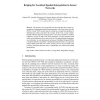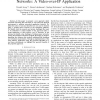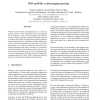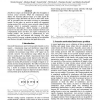WCNC
2008
IEEE
14 years 5 months ago
2008
IEEE
— A cross-layer algorithm for geographic routing in Wireless Sensor Networks (WSNs) is proposed, which is robust to dead-ends and resilient to topological variations due to netwo...
WCNC
2008
IEEE
14 years 5 months ago
2008
IEEE
Abstract— In wireless sensor networks, one of the big challenges is to achieve a satisfactory network lifetime while meeting quality of service (QoS) requirements. In this paper,...
VTC
2008
IEEE
14 years 5 months ago
2008
IEEE
Abstract— Balancing energy consumption and prolonging network lifetime are open challenges in Wireless Sensor Networks. In this paper, we design a novel load balanced routing pro...
SUTC
2008
IEEE
14 years 5 months ago
2008
IEEE
Broadcast and convergecast are two fundamental operations in wireless sensor networks. Although previous works have addressed energy-efficient and low-latency scheduling, these w...
SUTC
2008
IEEE
14 years 5 months ago
2008
IEEE
Testing and verification methodologies for Wireless Sensor Networks (WSN) systems in pre-deployment are vital for a successful deployment. Increased visibility of the internal st...
SSDBM
2008
IEEE
14 years 5 months ago
2008
IEEE
Abstract. The presence of coverage holes can adversely affect the accurate representation of natural phenomena being monitored by a Wireless Sensor Network (WSN). Current WSN resea...
SECON
2008
IEEE
14 years 5 months ago
2008
IEEE
—In this paper we present a new approach called cue-based networking that uses hints or cues about the physical environment to optimize networked application behavior. We define...
SECON
2008
IEEE
14 years 5 months ago
2008
IEEE
In 2003, the MIT Technology Review magazine listed wireless sensor networks as one of “Ten Emerging Technologies That Will Change the World” [2]. Five years later, are wireles...
SASO
2008
IEEE
14 years 5 months ago
2008
IEEE
Wireless sensor networks are designed for a very wide, yet specific, purpose. Their components have processing and power limitations. Due to these limitations, decisions by runni...
SAINT
2008
IEEE
14 years 5 months ago
2008
IEEE
Interference ranges can dramatically affect the throughput in wireless sensor networks. While the transmission range defines the maximum physical range of a radio signal the inter...




